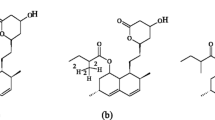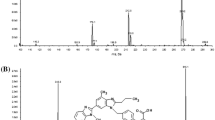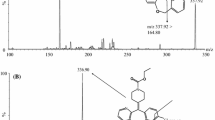Abstract
The aim of the proposed work was to develop and validate a simple and sensitive assay for the analysis of atorvastatin (ATV) acid, ortho- and para-hydroxy-ATV, ATV lactone, and ortho- and para-hydroxy-ATV lactone in human plasma using liquid chromatography-tandem mass spectrometry. All six analytes and corresponding deuterium (d5)-labeled internal standards were extracted from 50 μL of human plasma by protein precipitation. The chromatographic separation of analytes was achieved using a Zorbax-SB Phenyl column (2.1 mm × 100 mm, 3.5 μm). The mobile phase consisted of a gradient mixture of 0.1% v/v glacial acetic acid in 10% v/v methanol in water (solvent A) and 40% v/v methanol in acetonitrile (solvent B). All analytes including ortho- and para-hydroxy metabolites were baseline-separated within 7.0 min using a flow rate of 0.35 mL/min. Mass spectrometry detection was carried out in positive electrospray ionization mode, with multiple-reaction monitoring scan. The calibration curves for all analytes were linear (R 2 ≥ 0.9975, n = 3) over the concentration range of 0.05–100 ng/mL and with lower limit of quantitation of 0.05 ng/mL. Mean extraction recoveries ranged between 88.6–111%. Intra- and inter-run mean percent accuracy were between 85–115% and percent imprecision was ≤ 15%. Stability studies revealed that ATV acid and lactone forms were stable in plasma during bench top (6 h on ice-water slurry), at the end of three successive freeze and thaw cycles and at −80 °C for 3 months. The method was successfully applied in a clinical study to determine concentrations of ATV and its metabolites over 12 h post-dose in patients receiving atorvastatin.

Chromatogram of atorvastatin and metabolites obtained with postcolumn infusion shows no matrix effect at the retention times of analytes and IS. Arrow indicates region where the signal of compounds infused post-column is suppressed during the elution of endogenous matrix components




Similar content being viewed by others
Abbreviations
- ATV:
-
Atorvastatin acid
- C max :
-
Peak plasma concentration
- CYP3A4:
-
Cytochrome P450 3A4
- HMG-CoA:
-
3-Hydroxy-3-methylglutaryl-coenzyme A
- HPLC:
-
High-performance liquid chromatography
- HQC:
-
High-level quality control
- IS:
-
Internal standard
- LC-MS/MS:
-
Liquid chromatography-tandem mass spectrometry
- LLOQ:
-
Lower limit of quantitation
- LQC:
-
Low-level quality control
- MRM:
-
Multiple-reaction monitoring
- PK:
-
Pharmacokinetics
- QCs:
-
Quality control samples
- S/N:
-
Signal-to-noise ratio
- UGTs:
-
UDP-glucuronosyltransferase
References
Breslow JL (1997) Cardiovascular disease burden increases, NIH funding decreases. Nat Med 3:600–601
Xu JK, Kochapek D, Murphy SL, Tejada-Vera B (2010) Deaths: final data for 2007. Natl Vital Stat Rep 58:1–73
Lennernas H (2003) Clinical pharmacokinetics of atorvastatin. Clin Pharmacokinet 42:1141–1160
Schuster NM, Rogers MA, McMahon LF Jr (2010) Using search engine query data to track pharmaceutical utilization: a study of statins. Am J Manag Care 16:e215–e219
Jacobsen W, Kuhn B, Soldner A, Kirchner G, Sewing KF, Kollman PA, Benet LZ, Christians U (2000) Lactonization is the critical first step in the disposition of the 3-hydroxy-3-methylglutaryl-CoA reductase inhibitor atorvastatin. Drug Metab Dispos 28:1369–1378
Kearney AS, Crawford LF, Mehta SC, Radebaugh GW (1993) The interconversion kinetics, equilibrium, and solubilities of the lactone and hydroxyacid forms of the HMG-CoA reductase inhibitor, CI-981. Pharm Res 10:1461–1465
Kantola T, Kivisto KT, Neuvonen PJ (1998) Effect of itraconazole on the pharmacokinetics of atorvastatin. Clin Pharmacol Ther 64:58–65
Poli A (2007) Atorvastatin: pharmacological characteristics and lipid-lowering effects. Drugs 67(Suppl 1):3–15
Schachter M (2005) Chemical, pharmacokinetic and pharmacodynamic properties of statins: an update. Fundam Clin Pharmacol 19:117–125
Thompson PD, Clarkson P, Karas RH (2003) Statin-associated myopathy. JAMA 289:1681–1690
Hermann M, Bogsrud MP, Molden E, Asberg A, Mohebi BU, Ose L, Retterstol K (2006) Exposure of atorvastatin is unchanged but lactone and acid metabolites are increased several-fold in patients with atorvastatin-induced myopathy. Clin Pharmacol Ther 79:532–539
Skottheim IB, Gedde-Dahl A, Hejazifar S, Hoel K, Asberg A (2008) Statin induced myotoxicity: the lactone forms are more potent than the acid forms in human skeletal muscle cells in vitro. Eur J Pharm Sci 33:317–325
Erk N (2004) Development of electrochemical methods for determination of atorvastatin and analytical application to pharmaceutical products and spiked human plasma. Crit Rev Anal Chem 34:1–7
Altuntas TG, Erk N (2004) Liquid chromatographic determination of atorvastatin in bulk drug, tablets, and human plasma. J Liq Chromatogr Related Technol 27:83–93
Bahrami G, Mohammadi B, Mirzaeei S, Kiani A (2005) Determination of atorvastatin in human serum by reversed-phase high-performance liquid chromatography with UV detection. J Chromatogr B Analyt Technol Biomed Life Sci 826:41–45
Shen HR, Li ZD, Zhong MK (2006) HPLC assay and pharmacokinetic study of atorvastatin in beagle dogs after oral administration of atorvastatin self-microemulsifying drug delivery system. Pharmazie 61:18–20
Zarghi A, Shafaati A, Foroutan SM, Khoddam A (2005) A simple and rapid HPLC method for the determination of atorvastatin in human plasma with UV detection and its application to pharmacokinetic studies. Arzneimittelforschung 55:451–454
Shum YY, Huang N, Walter G, Black A, Sekerke C, Chang T, Whitfield LR (1998) Development, validation, and interlaboratory comparison of an HMG-CoA reductase inhibition assay for quantitation of atorvastatin in plasma matrices. Ther Drug Monit 20:41–49
Valesky RJ, Liu L, Musson DG, Zhao JJ (2008) Automated enzyme inhibition assay method for the determination of atorvastatin-derived HMG-CoA reductase inhibitors in human plasma using radioactivity detection. J pharmacol toxicol methods 57:61–69
Van Pelt CK, Corso TN, Schultz GA, Lowes S, Henion J (2001) A four-column parallel chromatography system for isocratic or gradient LC/MS analyses. Anal Chem 73:582–588
Miao XS, Metcalfe CD (2003) Determination of pharmaceuticals in aqueous samples using positive and negative voltage switching microbore liquid chromatography/electrospray ionization tandem mass spectrometry. J Mass Spectrom 38:27–34
Borek-Dohalsky V, Huclova J, Barrett B, Nemec B, Ulc I, Jelinek I (2006) Validated HPLC-MS-MS method for simultaneous determination of atorvastatin and 2-hydroxyatorvastatin in human plasma-pharmacokinetic study. Anal Bioanal Chem 386:275–285
Bullen WW, Miller RA, Hayes RN (1999) Development and validation of a high-performance liquid chromatography tandem mass spectrometry assay for atorvastatin, ortho-hydroxy atorvastatin, and para-hydroxy atorvastatin in human, dog, and rat plasma. J Am Soc Mass Spectrom 10:55–66
Guillen D, Cofan F, Ros E, Millan O, Cofan M, Rimola A, Brunet M (2009) Determination of atorvastatin and its metabolite ortho-hydroxyatorvastatin in human plasma by on-line anion-exchange solid-phase extraction and liquid chromatography tandem mass spectrometry. Anal Bioanal Chem 394:1687–1696
Hermann M, Christensen H, Reubsaet JL (2005) Determination of atorvastatin and metabolites in human plasma with solid-phase extraction followed by LC-tandem MS. Anal Bioanal Chem 382:1242–1249
Jemal M, Ouyang Z, Chen BC, Teitz D (1999) Quantitation of the acid and lactone forms of atorvastatin and its biotransformation products in human serum by high-performance liquid chromatography with electrospray tandem mass spectrometry. Rapid Commun Mass Spectrom 13:1003–1015
Liu D, Jiang J, Zhou H, Hu P (2008) Quantitative determination of atorvastatin and para-hydroxy atorvastatin in human plasma by LC-MS-MS. J Chromatogr Sci 46:862–866
Ma L, Dong J, Chen XJ, Wang GJ (2007) Development and validation of atorvastatin by LC–ESI–MS and application in bioequivalence research in healthy chinese volunteers. Chromatographia 65:737–741
Nirogi RV, Kandikere VN, Shukla M, Mudigonda K, Maurya S, Boosi R, Anjaneyulu Y (2006) Simultaneous quantification of atorvastatin and active metabolites in human plasma by liquid chromatography-tandem mass spectrometry using rosuvastatin as internal standard. Biomed Chromatogr 20:924–936
Novakova L, Vlckova H, Satinsky D, Sadilek P, Solichova D, Blaha M, Blaha V, Solich P (2009) Ultra high performance liquid chromatography tandem mass spectrometric detection in clinical analysis of simvastatin and atorvastatin. J Chromatogr B Analyt Technol Biomed Life Sci 877:2093–2103
US Department of Health and Human Services. Food and Drug Administration (FDA). Center for Drug Evaluation and Research (CDER). Guidance for Industry. Bioanalytical Method Validation (2001) See http://www.fda.gov/cder/guidance/4252fnl.htm. Accessed Feb 2011
Prueksaritanont T, Subramanian R, Fang X, Ma B, Qiu Y, Lin JH, Pearson PG, Baillie TA (2002) Glucuronidation of statins in animals and humans: a novel mechanism of statin lactonization. Drug Metab Dispos 30:505–512
Billecke S, Draganov D, Counsell R, Stetson P, Watson C, Hsu C, La Du BN (2000) Human serum paraoxonase (PON1) isozymes Q and R hydrolyze lactones and cyclic carbonate esters. Drug Metab Dispos 28:1335–1342
Amberg S, Loevenhart AS (1908) Further observations on the inhibiting effect of fluorides on the action of lipase, together with a method for the detection of fluorides in food products. J Biol Chem 4:149–164
Wang S, Cyronak M, Yang E (2007) Does a stable isotopically labeled internal standard always correct analyte response? A matrix effect study on a LC/MS/MS method for the determination of carvedilol enantiomers in human plasma. J Pharm Biomed Anal 43:701–707
Zhang G, Wujcik CE (2009) Overcoming ionization effects through chromatography: a case study for the ESI-LC-MS/MS quantitation of a hydrophobic therapeutic agent in human serum using a stable-label internal standard. J Chromatogr B Analyt Technol Biomed Life Sci 877:2003–2010
Acknowledgments
The authors gratefully acknowledge the financial support of American Heart Association award #0855761D. Use of an API 4000 mass spectrometer provided as a collaboration agreement with AB Sciex is gratefully acknowledged.
Author information
Authors and Affiliations
Corresponding author
Rights and permissions
About this article
Cite this article
Macwan, J.S., Ionita, I.A., Dostalek, M. et al. Development and validation of a sensitive, simple, and rapid method for simultaneous quantitation of atorvastatin and its acid and lactone metabolites by liquid chromatography-tandem mass spectrometry (LC-MS/MS). Anal Bioanal Chem 400, 423–433 (2011). https://doi.org/10.1007/s00216-011-4804-y
Received:
Revised:
Accepted:
Published:
Issue Date:
DOI: https://doi.org/10.1007/s00216-011-4804-y




